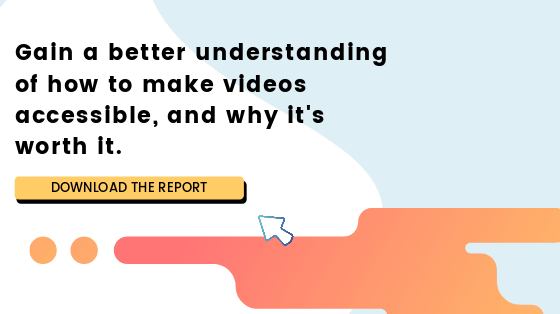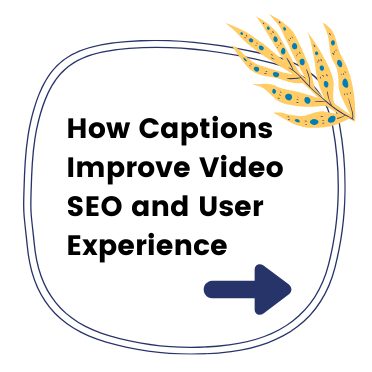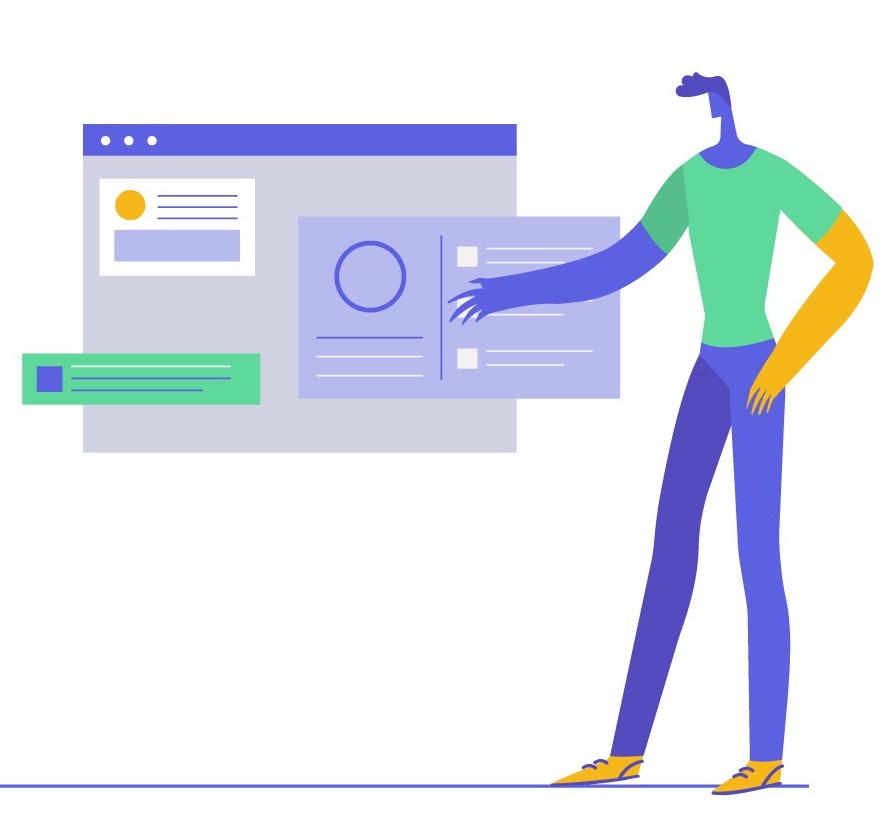Making a Business Case for Captioning Your Online Videos
Updated: February 7, 2024
Are you on the fence about buying-in to closed captioning for your video content? You are not alone. There are many organizations on the lookout for a business case for captioning that makes sense.
Below, we’ve built a case for captioning to show just how much value it can provide your business.
The Opportunity
Captioning is an opportunity to provide your audience with a viewing experience that fits their needs and expectations.
First and foremost, captions make videos accessible to people who are deaf or hard of hearing. However, 80% of people who use captions do not have any hearing loss. Many recent studies and reports have found that closed captions also provide a plethora of benefits to all viewers.
Improved Viewing Experience
There are several reasons why viewers not only want captioned videos but expect it. Current audiences are reportedly shying away from watching videos with sound. Verizon and Publicis Media found that 69 percent of viewers watch videos with the sound off when they’re in public settings. On the other hand, 25 percent watch videos with the sound off even in private settings, such as in their own homes. Viewers who prefer the silent viewing experience expect closed captions.
All in all, captions make a real impact on the viewing experience:
- 37% report that captioning encourages them to turn sound on because it made them more interested in the video.
- 80% are more likely to watch an entire video when captions are provided.
- 50% expect to find captions on all types of video content.
Better Brand Experience
The reality is that it’s getting more challenging for brands to stand out. There are many things that companies can do to get in front of consumers, and captioning is one of them.
Danisha Lomax, VP and director of paid social at Digitas North America says, “Brands are starting to incorporate the use of captions into their best practices in order to ensure that people are digesting the content they’re visually consuming.”
A study from the Journal of the Academy of Marketing Science found that captions improve brand recall, verbal memory, and behavioral intent. Who knew that captions could have such a favorable implication for your brand in the eyes of the consumer?
Captioning also has a direct impact on SEO. Captioned videos get more search engine traffic, rank higher, and rank for more diverse keywords. According to Facebook, videos with captions have 135% greater organic search traffic.
We can’t forget to mention that captions also correlate with better user experience. They ensure that the information in a video is clear regardless of difficult language, poor audio, or complicated information.
Captions make watching video on the go more feasible for viewers. It provides the viewing flexibility that consumers crave so that they can watch content in any environment.
Captioning is a sure-fire way to take your brand to the next level and make a greater impact on your audience. That’s quite the business case for captioning.
Real-Life Results
Let’s put captions to the test. How have real-life companies benefited from captioning their video content?
Discovery Digital Networks
Discovery Digital Networks produces original programming for its viewers. They decided to start captioning their Youtube videos and had the goal to quantify the value of captions.
- There was an overall increase in views of 7.32% for captioned videos.
- Captioned videos ranked higher in YouTube search rankings.
- Captions can provide a potential 10x return on investment.
Discovery Digital Networks’ study shows that adding closed captions to videos can have a dramatic and immediate impact on views, and by extension, revenue.
Read More Case Studies Like This ➡️The Costs
The cost of captioning refers to two things: The cost that your organization will pay to caption your video content, and the price that your organization could have to pay if you don’t caption at all.
Let’s explore both:
The Cost of In-House Captioning
The assumption is often that professional captioning services are more expensive than captioning in-house. However, is that true?
Let’s take a closer, more calculated look.
An untrained transcriptionist, such as a student or intern, may take five hours or more to transcribe a one hour file. If this student is paid $15 per hour, this means it will cost $75 to transcribe a one-hour long file.
(5 hours) x ($15/hour) = $75 for one-hour video file
Transcription is just the first step, however. Next, you’ll have to time-synchronize the file. This is often the hardest part because you have to make sure that each caption frame aligns nearly perfect with the audio.
With the use of free tools such as YouTube, the process of synchronization is a bit easier. Let’s assume that with a free tool, synchronization adds an hour to the captioning process.
(1 hour) x ($15/hour) = $15 for one-hour video file
Now the cost rises to $90 per hour of content.
The next step is quality control, which ensures caption accuracy. We must also include operational costs that fund training, hiring, managing, and scheduling.
After all costs and steps are accounted for, a conservative estimate for in-house, large-scale captioning operation averages $165 per hour of video, which is more than double the cost of hiring a professional captioning service.
Total estimated cost for in-house captioning = $165/hour of video
The Cost of Third-Party Solutions
If you have many hours of video content, you’ll quickly realize that sustaining an in-house captioning operation is expensive and requires substantial resource time. The other, more practical option may be to use a third-party captioning vendor.
Most captioning vendors charge per minute. Prices can range from $1 per minute to $15 per minute. With that in mind, the price could range anywhere from $60 to $900 per hour-long video file.
Some vendors charge fees for additional capabilities such as multiple speakers, caption formats, resubmissions, and even video platform integrations. Fees can also be charged based on the turnaround you select; faster turnarounds tend to cost a bit more.
Furthermore, you should always consider quality. Some vendors promise a 99% accuracy rate but fall drastically short of this standard. For example, if a vendor splits your files into segments, then divides these segments across multiple transcribers, there may be many inconsistencies and accuracy issues.
The Cost of Not Captioning
Captioning does indeed cost money. There’s no getting around it. However, it turns out that not captioning your videos could cost you, too.
Lost Revenue Opportunities
Public-facing videos should be accessible. Captions make videos more accessible to people with sensory disabilities such as hearing loss, with chronic conditions such as ADHD or ADD, and with learning disabilities such as Dyslexia. This ensures that customers or potential customers are not excluded from enjoying your content.
Without captioning, just how many people are you excluding?
- There are approximately 7,327,800 blind people over age 16 in the US.
- Approximately 15% of American adults 18 and older report some trouble hearing.
- An estimated 35,000-40,000 American adults are deaf-blind.
- One in 12 men and one in 200 women are color blind.
- 4% of American adults are diagnosed with ADD or ADHD.
- Over 40 million American adults have Dyslexia.
Beyond the immediate loss of opportunities from customers with disabilities, you risk damaging your brand. A lack of accessibility in videos could be perceived as antiquated since accessible design is a hallmark of forward-thinking and inclusive companies.
By captioning your content, your brand will be perceived in a better light. You’ll provide a convenient and considerate user experience, which may have a positive impact on your revenue stream.
Legal Damages
Getting hit with a disability discrimination lawsuit is another cost of inaccessibility. The Americans with Disabilities Act (ADA) protects the rights of employees and job applicants from being excluded based on their disability.
In the case of the National Federation of the Blind v. Target, Target was sued for not providing an accessible website. The result of the suit was that Target was responsible for paying out a $6,000,000 settlement fund for violating the Americans with Disabilities Act. Additionally, Target had to pay the plaintiff’s attorney’s fees and litigation fees in the total of $3,738,864.96. Target also agreed to update their website and policies to be more accessible.
If Target had led with accessibility, it would have saved them millions of dollars as well as the hassle of enduring a lawsuit.
Key Takeaways
There are three main points to take note of when considering the business case for captioning:
The cost of captioning using in-house methods can be significantly more expensive and more time-consuming compared to utilizing a third-party vendor. Pricing usually ranges from $1 per minute to $15 per minute, but it’s essential to vet for vendors that deliver high-quality captions (at least 99% accuracy).
The cost of not captioning could be detrimental to your business. There are millions of people in the world with a disability who may not have access to your content, all of whom are lost opportunities for new customers, followers, brand champions, and so forth. You also risk being hit with an accessibility lawsuit that could cost your company millions.
Captioning is a valuable opportunity for businesses that yields an improved user experience, more powerful branding, and potentially higher revenue streams from video projects.

Further Reading

Subscribe to the Blog Digest
Sign up to receive our blog digest and other information on this topic. You can unsubscribe anytime.
By subscribing you agree to our privacy policy.










